20+ Hacks for Camping in the Rain with Pets
There is something so relaxing about rain – the soothing pitter-patter of raindrops on the roof and the fresh, earthy smell that fills the air around us.
However, the weather forecast may not leave you feeling relaxed if you know you’re preparing to head out camping in the rain with pets.
From setting up a tent in the rain to keeping your bedding clean and dry, there are some unique challenges to consider!
Fear not; we have you covered! In this blog post, we’ve compiled a list of our go-to tips and hacks for camping in the rain with pets.
We’ll discuss extra gear you may want to include on your packing list, activities to keep your high-energy pets busy when camping in a rainstorm, setup/tear-down tips, and more.
By the end, you’ll be confident heading into your next camping adventure, even if the weather forecast looks a little wet and rainy!

This post contains affiliate links, which means if you click and buy, we will make a commission (at no cost to you). See my full disclosure policy for more details.
How to Set Up a Tent in the Rain
Earlier this month, we pulled into Silent Lake Provincial Park for our Thanksgiving camping trip to set up our walk-in campsite in the dark and the rain.
It was clear this wasn’t the easiest setup we had ever experienced, especially with the three dogs alongside us.
During the setup process, your tent is vulnerable to rain, meaning you could have a wet tent before it’s even fully assembled – a rough start to any cool, rainy weekend!
So, how did we approach getting set up for tent camping in the rain?
Make sure you are using a tent that is prepared for wet weather. It should have a full rainfly and be waterproofed at the start of each season.
When we arrive at the campsite, the first thing we do when the weather is even remotely questionable is set up our largest tarp.
Doing so provides a place to keep the dogs sheltered, store your gear out of the rain, and stay as dry as possible when setting up the rest of your campsite.
At this particular campsite, we set up a second tarp near the first, under which we set up our tent for the weekend.
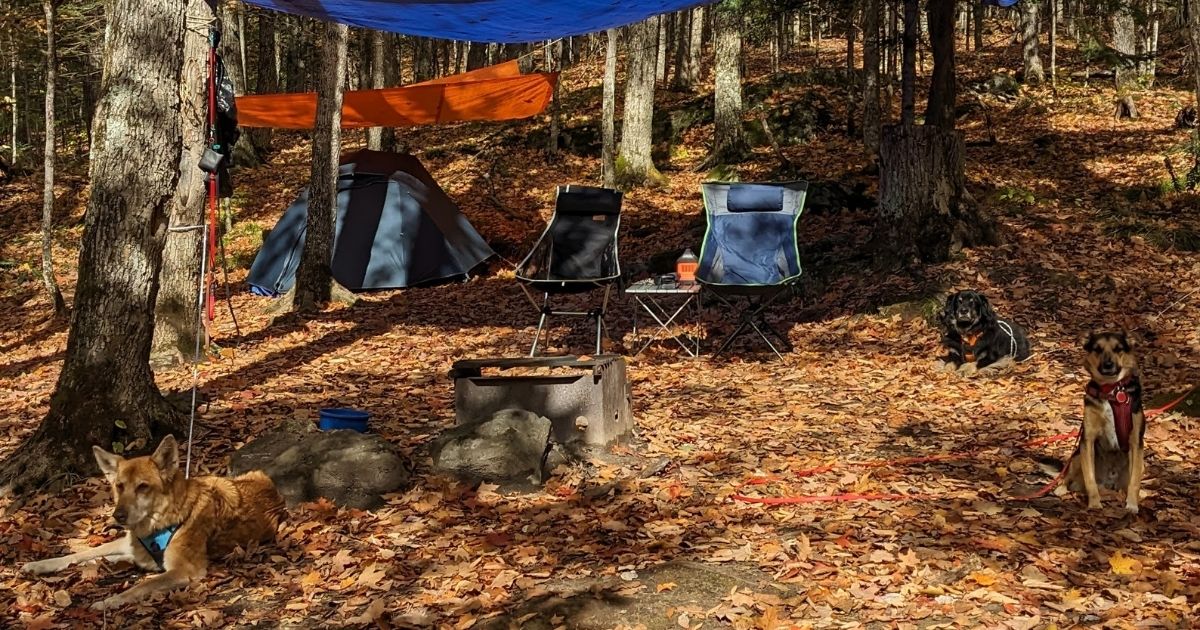
When choosing the spot to set up your tent, pay careful attention to any hills, slopes, or running water.
This is one benefit of setting up in the rain – you can clearly see the routes the water wants to take through the site, allowing you to avoid positioning yourself with it running directly into your tent.
20+ Hacks for Camping in the Rain with Pets
Whether you’re currently sitting at a campsite with the rain pouring down, trying to figure out the best way to navigate the situation, or planning a trip in the near future with a questionable forecast, you’re here for a solution.
Unfortunately, there is no one-size-fits-all solution for how to deal with rain while camping.
The best approach will vary depending on your camping style, the gear you have at your disposal, your plans during your trip, and even your dog’s personality.
Here is a list of 20+ camping hacks for rain and wet weather. – there are sure to be options that will work for your situation!
Pay Attention to the Forecast
First, pay attention to the forecast in the days leading up to your next outdoor adventure.
This information may not be 100% accurate (is it ever), but it will help you to plan for the possibility of wet, rainy weather, should that be predicted.
Keeping an eye on the weather throughout your trip will also ensure you’re prepared if the weather takes a turn for the worse.
We prefer the Instant Weather app and their text message alerts ($4.49/month), which keep us updated about any potentially concerning weather even if we don’t have data service (which happens quite often, given the type of rustic camping we enjoy).
Suit Up for the Rain
When packing for your trip, make sure to include rain gear for both you and your pup.
This may not be as important if you are just hanging around the campsite. After all, your dog can stay dry and comfortable under the tarp most of the day.
However, if you plan to enjoy any outdoor activities like hiking, canoeing, or kayaking, you must plan accordingly.
We wish we had brought a doggy raincoat or slush suit this last trip for Lucifer after it started raining halfway through our hike of the Lakeshore Trail at Silent Lake PP.
Pack Indoor-Friendly Pet Activities
If you have a high-energy dog, like our boy Lucifer, then the idea of keeping your dog contained in a small space for an extended period is a little intimidating.
Without proper exercise, these pups can go CRAZY! Right?
The secret to success is to prepare yourself with indoor-friendly activities that prevent boredom and provide mental stimulation.
Some of our go-to activities and products include:
- Snuffle mats
- Puzzle feeders
- Interactive treat toys
- Lick mats
- Training sessions
- Tasty chews
- Games like tug
Pairing these activities with a walk or two each day (depending on your dog’s energy level and needs) will help to keep them relaxed and entertained, keeping the “cabin fever” (or tent fever) at bay.
Store Gear in Waterproof Containers
Keeping your gear dry is essential, especially when dealing with your dog’s food and treats, bedding (yours and theirs), and clothing.
So, how do you ensure that everything stays dry?
All our gear is kept in large plastic waterproof totes on car camping or front country adventures.
They can be left outside in the rain if space under the tarp is limited, pulling them into shelter only when they need to be opened.
The totes are also easy to move as they have convenient handles.
For backpacking, consider using dry bags or placing items that need to stay dry in Ziplock bags for an added layer of protection.
Use Your Tent’s Guylines
If you are an experienced tent camper, this may be a point that you can pass right over. However, if you are new to sleeping in a tent, this is for you!
Have you noticed that there are ropes attached to the exterior of your tent?
These are called guylines. They help secure the tent down in the wind but also hold the rain fly in a position where any water will run off it instead of pooling (leading to possible leaks).
Here, we removed the pegs from the guylines on our tent during the rain so you could see how it may lead to trouble.
You can see the spot where the rain fly is folding, creating an area likely to collect water.
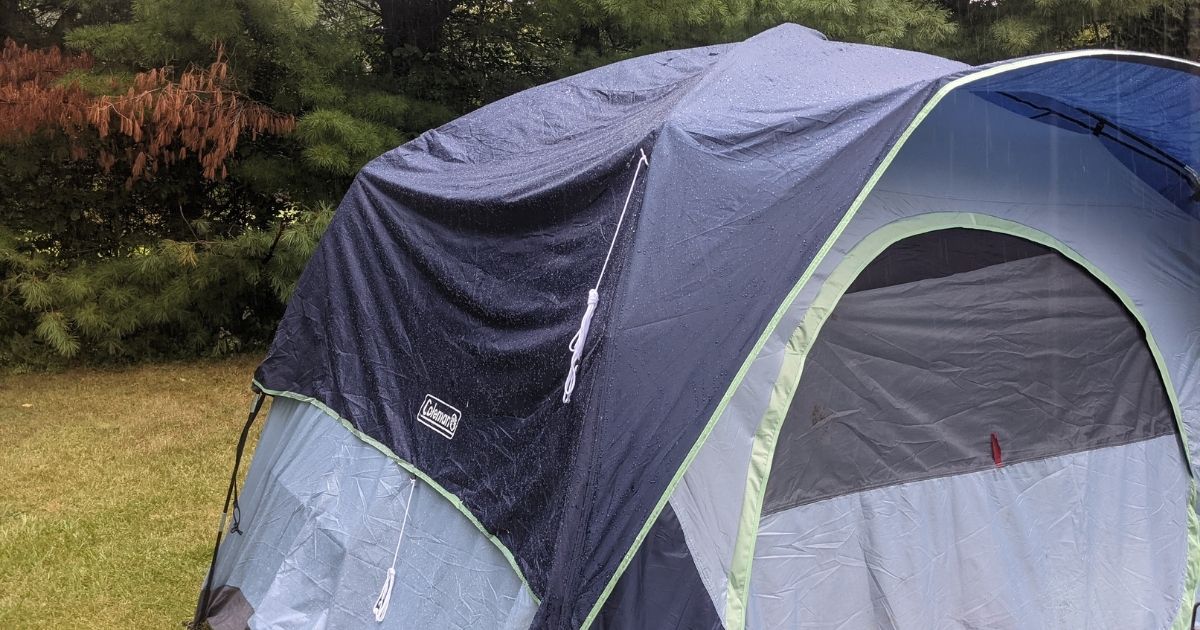
Each guyline should be secured with a peg, adjusting them to create a tight (but not too taut) rainfly that the water can easily roll off.
If you are concerned about pets or children tripping over the lines, consider adding a small flag to the rope, like a bandana, or swapping your current ropes for glow-in-the-dark ropes for nighttime.
Pay Attention to Pooling on Tarps and Canopies
Speaking of water pooling, watch any tarps or canopies closely.
If you notice that the water is pooling, try emptying it by pushing up on the bottom of the tarp, but be careful not to dump it on yourself or anyone else (including your pet).
Consider readjusting your ropes to prevent water from pooling moving forward, if possible.
Create a Dry Pet Area
One of the biggest challenges can be keeping our dogs dry, especially if you have dogs like ours that will happily go out and play in the rain.
Secure their tie out so that they have a safe, covered area to relax.
You can set this space up using a tarp for a covered area or a shelter like the KUMA Bear Den Gazebo with its privacy panels, as we do when car camping.
You can keep their water dish, food, toys, and a dog bed here.
Our dogs are much more likely to stay in this space if we also hang out in the same general area so that they have their whole “pack” together.
For our cats, we ensure that their kitty pen is set up inside the sheltered area, far enough away from the shelter’s walls or edges of the tarp to minimize any rain that could be blown in.
You can also put up tarp walls and barriers to help with this.
Set Up a Clothesline
Wet clothing can be a nuisance when you’re camping – especially if you are working with limited gear due to space constraints, like when you’re backpacking.
Try setting up a clothesline under your tarp, close to your fire pit.
Here, you can hang items to dry using the heat of the fire rather than keeping them balled up in a corner of the tent, adding to the condensation inside.
They may even dry out enough that you can re-wear your warmest, most cozy items.
Light Up the Campsite
Of course, when talking about tips for camping in the rain, we must address the fact that it doesn’t only rain during the day.
You will be navigating your site in the dark – trying to avoid stepping in puddles or slipping in the mud.
One of the best things you can do for nighttime safety is to have a reliable lighting option.
This could mean having lanterns you can set out on the site or carry with you as you move about. Or it could mean using flashlights or headlamps.
We prefer headlamps on our adventures as they leave our hands free to deal with the pets.
I currently use and love my Everbeam H6 Switch LED Headlamp with a rechargeable battery because it is compact, bright, long-lasting, and comfortable.
Dry Your Dog Off Every Night
One aspect of wet weather adventuring that is often overlooked is the importance of drying your pet off for their health and comfort.
Not only may wet fur lead to feeling cold, depending on their breed, but it can cause skin irritation.
Hot spots, a common condition in dogs, are caused when moisture is trapped against a dog’s skin long enough that it causes inflammation or infection in the area.
This is most seen during the summer, but it can happen anytime.
If your dog gets soaked during the day, towel them off when you return to your dry hangout area before they settle in to relax.
At night, even if they appear to be “just damp,” give them a quick towel off as an added precaution.
Make Sure to Bring Your Pet-Friendly First Aid Kit
Another important consideration relating to your pet’s health and well-being is ensuring that you have a fully stocked, pet-friendly first aid kit at your campsite.
This is necessary in any weather, but rainy weather introduces new risks.
For example, you and your pet may find your footing less reliable with wet rocks and mud patches throughout the site.
If you’re unsure of whether your current first aid kit has everything necessary for both you and your travel companion, check out our printable checklists:
Place a Mat at Your Tent Door
If you have the space to add a small doormat to your gear, we highly recommend it.
This will help keep the dirt, mud, and grime out of your tent, both from your shoes and from your pup’s muddy paws.
This mat should be under the tarp or in the vestibule of your tent to protect it (and your shoes) from the rain.
For those of us with highly trainable dogs, teaching your pup to wait at the mat to have their paws cleaned before entering the tent doesn’t take long.
This brings us to the next point…
Clean Muddy Paws
You may be surprised by how much dirt your dog or cat can bring in on their paws (yes, some cats can get quite muddy too).
Keep your tent clean and cozy by taking a moment each time your pet enters to clean their paws.
Some pet parents will use a paw-cleaning device like the MudBuster Portable Dog Paw Cleaner or pet grooming wipes.
We use an old towel and rotate them when they get too dirty.
Keep Plenty of Towels on Hand
As I’ve already shared, we use towels to wipe our dogs’ paws and dry them off each day, but that’s not their only use.
On rainy trips, we keep several old towels in the vehicle. They come in handy when drying off people, pets, gear, and even the tent floor.
After all, there are days when you wind up so wet that drying off before going into the tent simply isn’t feasible…
Consider a Waterproof Blanket
Does your dog enjoy sleeping on your bed with you? If so, you may be dealing with a dog-shaped wet spot on your bedding.
Unfortunately, wet bedding can leave you feeling a chill on a colder day.
We regularly face this struggle as our girl Daviana’s fur tends to dry much slower than the boys, meaning she’s almost always wet when bedtime comes – but she sleeps on my feet.
The best solution we have found is to use a waterproof blanket (specifically, we use the Tall Tails Waterproof Dog Blanket) on top of my bedding.
Use a Tent Heater if it’s Cold
Are you considering off-season camping? If you are planning on winter, late fall, or early spring camping, then you may want to include a tent heater with your camping gear.
If you are camping somewhere with electricity, you can use a small space heater with tip-over and overheat protection.
For those of us who camp without electricity, there is the option to use a propane space heater like our favourite, the Mr. Heater Portable Buddy Heater.
Use the heater to take the chill off the tent before going to bed, not while you are sleeping, and always have a CO2 detector with you as an added security measure (even if the heater you are using has CO2 detection built-in).
Keep Wet and Muddy Gear Outside
As I mentioned when suggesting a clothesline, bringing wet clothing or gear into your tent can add to the moisture in the tent.
This leads to excess condensation on the tent itself and a damp feeling on anything inside it – including your bedding!
The best way to avoid this is to safely store all wet and muddy gear outside or in your vehicle in a plastic tote or travel laundry bag.
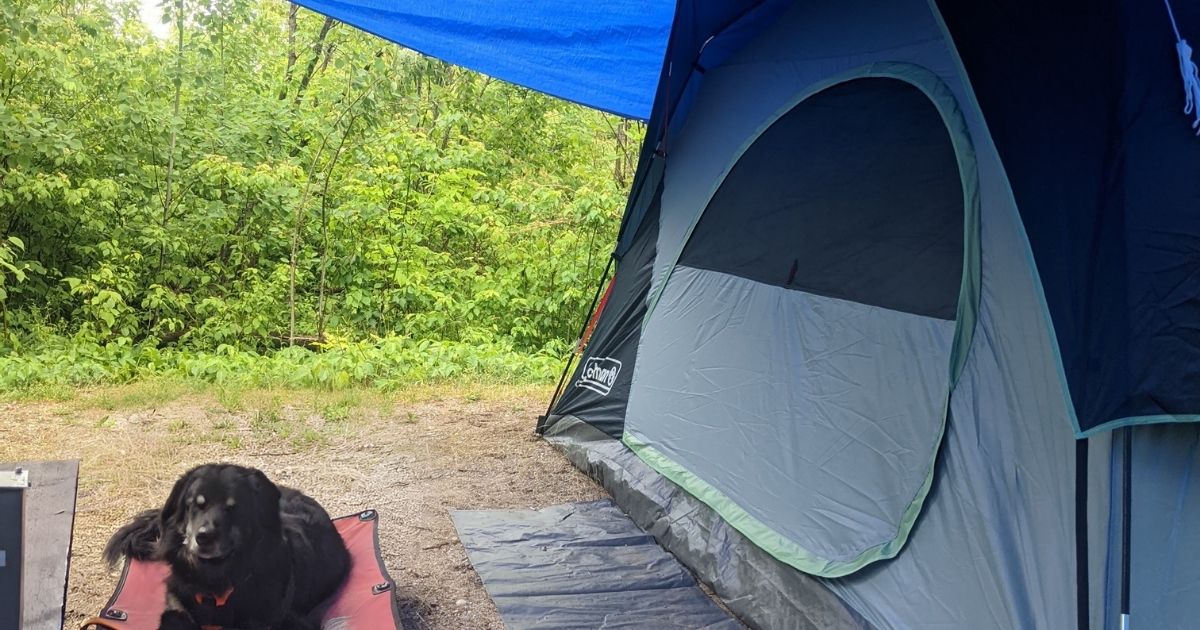
Regularly Check for Signs of Cold
Before heading out on any outdoor adventure in the off-season, consider whether it will be too cold for your dog or cat.
This will vary from pet to pet. For example, some breeds thrive in the cold, while others struggle to stay warm even in the fall months as the temperatures drop.
Senior dogs and cats, puppies, kittens, and some pets with medical conditions will be more sensitive to temperature changes.
If you know your dog is likely to feel the chill, consider using a coat or sweater to keep them feeling warm and cozy regardless of the weather.
Be Flexible with Timing for Outdoor Excursions
Are you planning to get out and explore the area, hiking or canoeing with your dog or cat?
Don’t let a little rain spoil your plans – but you need to be aware of the weather and adapt your plans accordingly.
When hiking in the rain, make sure that you are wearing rain gear, including waterproof boots.
Check the trail conditions by following the location’s social media accounts, calling ahead, or using an app like AllTrails to ensure they aren’t too muddy or rained out to use.
If you are watching the weather and radar closely, you may also be able to plan your outing during a break in the rain.
Prepare Some Comfort Food
Your body uses food and calories to help stay warm, meaning you can help fuel your body and set yourself up for success strategically with your food choices.
The same concept applies to your pet.
Root vegetables like carrots and sweet potatoes require more energy to digest, leading to a boost in body temperature – and they are both dog-friendly options!
You can also add warm water to your dog’s food to encourage better hydration and create a tasty gravy that your pup will love.
In addition to good food, always have fresh water available. Proper hydration is necessary to regulate body temperature.
Embrace the Campfire
Of course, hanging out around the campfire is an excellent way to stay warm while you hang out at your campsite on the colder nights.
It’s also a great way to dry off if you have been in the rain.
Be careful with pets getting too close to the fire as they may not recognize the danger, leading to a preventable injury.
We often set up our dogs’ camp cots close enough to the fire that they can feel the heat while maintaining a safe distance, then use the “place” command to keep them from approaching any closer.
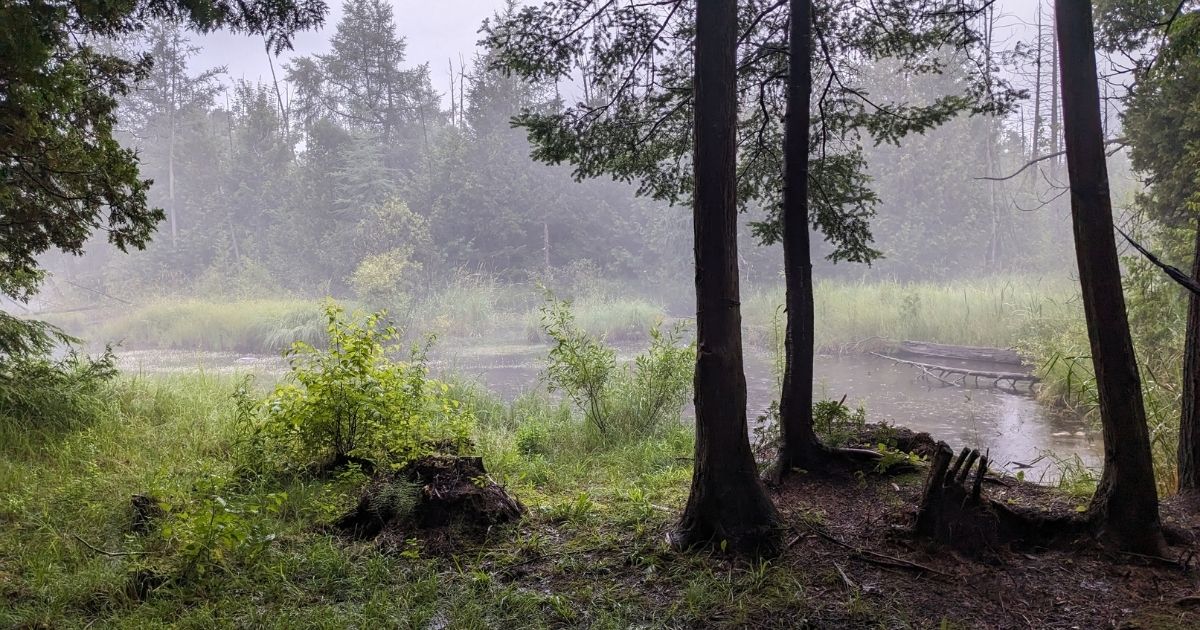
Don’t Stress the Mess
Most importantly, don’t let a little rain dampen your spirits or ruin the experience.
Sure, it may not be the ideal situation.
But that doesn’t mean you can’t make the most of the situation. This is an excellent opportunity to make memories and strengthen your bond with your pets.
You can’t control the weather (we all wish we could), but you can control your response and how you move forward.
Final Thoughts – Camping in the Rain with Pets
After reading all that, I hope you feel confident that you know what to do when camping in the rain and how to prepare yourself for your next big adventure.
After all, there is no such thing as “bad” weather. Even the rainiest day can bring about the happiest memories.
Set yourself up for success by being prepared, packing the appropriate gear, and setting your campsite up with the weather in mind.
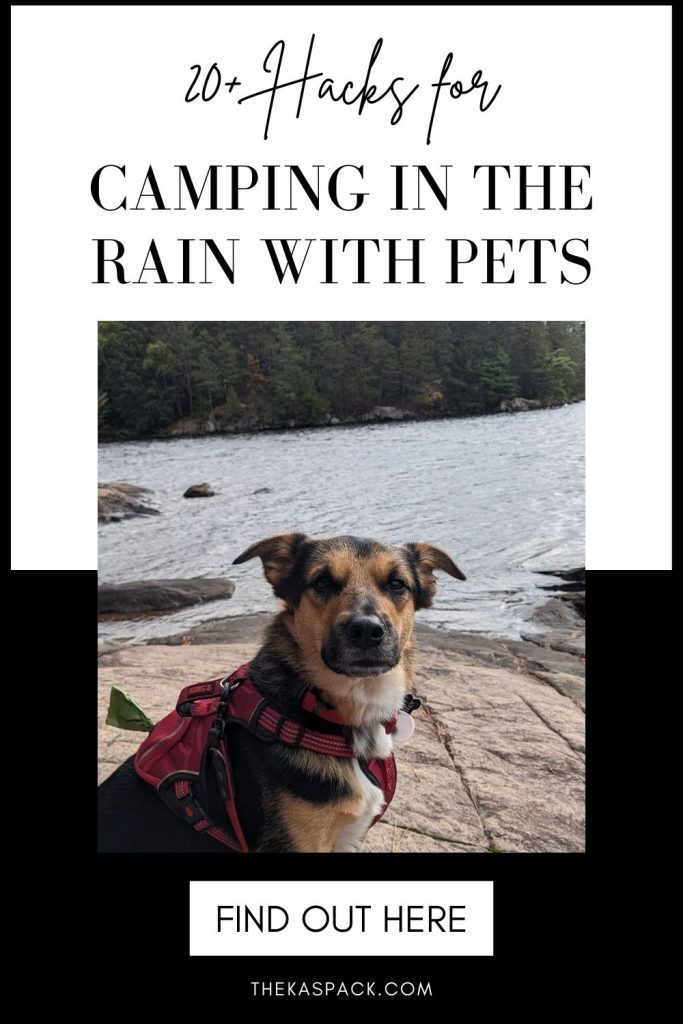
Do you have any hacks for camping in the rain with pets that we missed? We’d love to hear them! Share your thoughts, questions, and recommendations in the comments!
